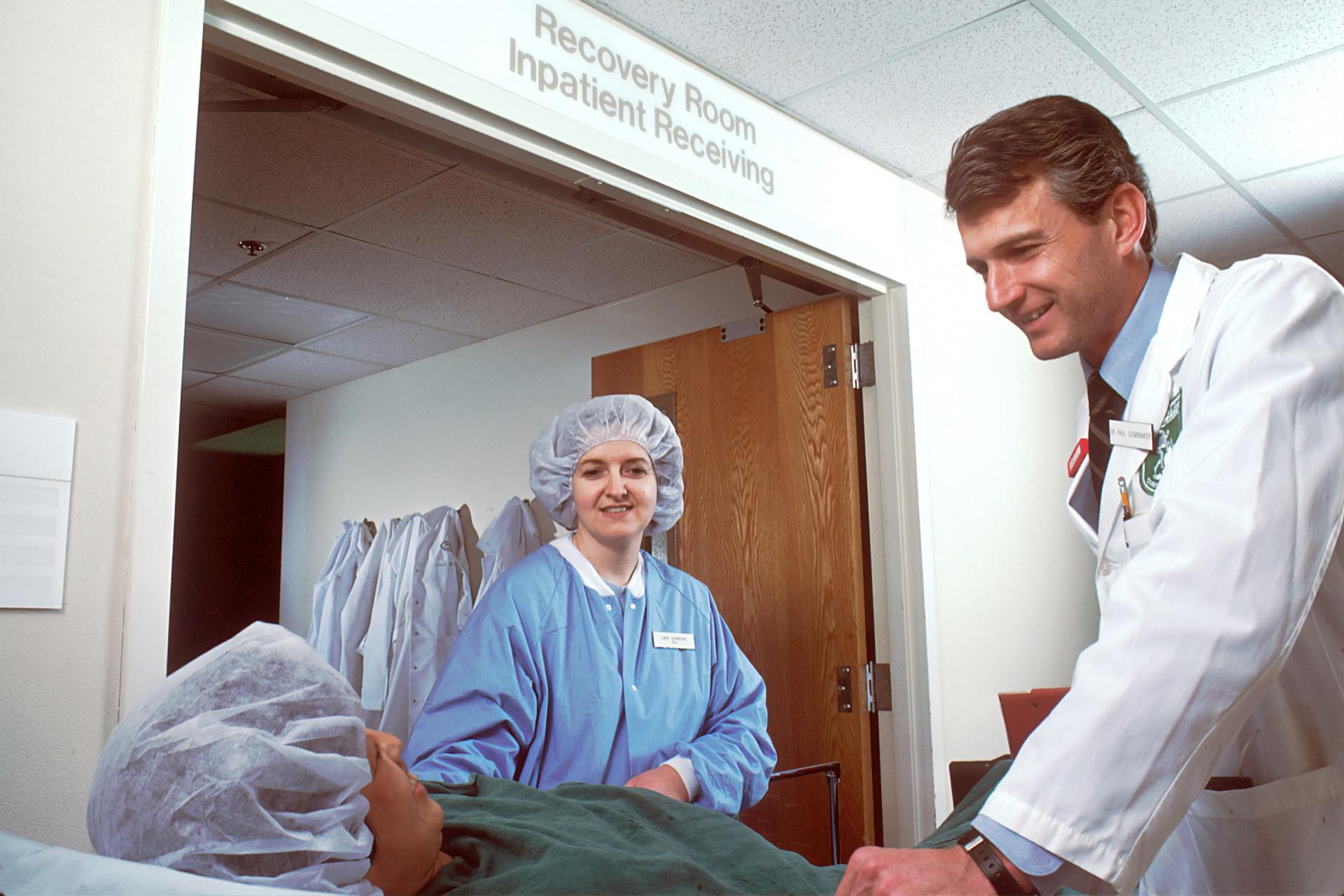Antimicrobial Stewardship
Post-prescription review
Key points
- Post-prescription review (PPR) is a patient-specific approach that involves review of the patient’s antimicrobial therapy, followed by feedback, which may include suggested modifications to optimise therapy.
- PPR should ideally be undertaken by a multidisciplinary team of various specialties. However, if resources are limited, PPR can still be effectively undertaken by a single clinician, provided that there is adequate access to expert advice.
- PPR ward rounds should ideally be conducted at least twice per week in areas of greatest need.
- Patients requiring review can be identified by referral from another clinician, prescription of a particular antimicrobial, a clinical condition, a laboratory result or prolonged antimicrobial therapy.
- Recommendations should be documented in the patient’s medical record and, if the advice is significant, be verbally communicated to the treating medical team.
- Advice may include: de-escalation based on microbiology and clinical improvement, rationalisation of therapy, cessation of therapy, dose optimisation, IV-to-oral switch, and escalation of therapy or escalation to formal infectious diseases review.
- PPR does not involve clinical examination of the patient; hence, care should be taken about the scope of the advice provided.
- AMS teams should keep records of their interventions, to keep track of the activity of the AMS program and also to help identify existing or emerging prescribing issues.
Post-prescription review (PPR) is a patient-specific approach that involves review of initial or ongoing antimicrobial therapy, followed by feedback, which may include suggested modifications to optimise therapy.
Regular ward rounds for PPR are an important part of the AMS team’s role. The ward rounds provide insight into many aspects of antimicrobial prescribing that may not be identified through more passive mechanisms of auditing. Regular AMS rounds also provide teaching opportunities for the junior and senior workforce, and can help to increase awareness of AMS across the health service.
Regular PPR has been associated with a reduction in the volume of prescribing of several key classes of antimicrobial agents in some hospitals, and significant cost savings. This regular review process provides the opportunity to re-evaluate the initial prescription by using information (e.g., microbiology and radiology test results) that may not have been available at the time that the antimicrobials were prescribed.
A key strength of PPR is that the individual patient’s clinical situation can be assessed. Empiric prescribing guidelines cannot encompass all clinical situations, and many important patient-specific factors require consideration throughout the duration of therapy.
Who should perform post-prescription review?
PPR may be undertaken by a single clinician, such as an infectious diseases physician or specialist pharmacist, or by a multidisciplinary team representing specialties such as infectious diseases, pharmacy, infection control and microbiology. Both approaches have been found to improve antimicrobial prescribing. However, the team approach is recommended as it is more likely to have a positive effect. The composition of the expert team will depend on the availability of local resources.
In hospitals without on-site infectious diseases physicians or specialist clinical pharmacists, nurses, general pharmacists or infection control practitioners with appropriate training can assist with PPR by identifying high-risk patients who require review. Further action regarding these patients might include:
- scanning copies of the medication charts and forwarding to an off-site specialist for review;
- having regular teleconferences with an off-site infectious diseases physician or clinical microbiologist to review patients' prescriptions and discuss cases; and
- including off-site experts in ward rounds of high-risk areas (e.g., intensive care units) using telehealth.
Which patients should be reviewed?
Review of a patient’s antimicrobial therapy may be triggered by:
- referral from another clinician;
- prescribing of a particular antimicrobial (e.g., a restricted broader-spectrum antimicrobial on the ‘watch’ or reserve lists);
- a laboratory result (e.g., Staphylococcus aureus positive blood culture);
- a clinical condition, such as sepsis or meningitis; and
- prolonged antimicrobial therapy (e.g., intravenous antimicrobials prescribed greater than 1 week).
The AMS team will need to determine best methods of identifying patients for clinical review. If available, pharmacy dispensing information or electronic tools can be used to identify patients on target antimicrobials. Routine AMS rounds should be done in clinical areas of high antimicrobial use, e.g., intensive care units, and haematology and oncology units. This can ensure that the AMS team’s expertise and advice are readily available to prescribers. Generally, a senior doctor for the treating unit attends the AMS ward round to discuss issues directly. The AMS team should also review the use of restricted antimicrobials across the whole hospital, and episodes of prolonged use of other antimicrobials.
The frequency of rounds depends on the size and resources of the hospital, and the types of admitted patients. Generally, an AMS team should aim to conduct ward rounds at least twice per week in areas of greatest need.
What should be included in the review and feedback?
The AMS team should document their review in the patient’s medical record, starting with the antimicrobials being reviewed and the documented indication for their use. Include any relevant clinical factors or investigation results that might influence the antimicrobial prescription.
The AMS team should assess the antimicrobial prescription, considering the following:
- the decision to prescribe an antimicrobial at all (i.e., is there an appropriate indication?);
- choice of antimicrobial;
- whether the prescription is in accordance with local or national guidelines;
- route of administration;
- dosage and frequency;
- allergy status;
- appropriateness for treatment of the suspected or confirmed pathogens; and
- duration of therapy.
A range of point-of-care interventions can be used to provide direct and timely feedback to the prescriber at the time of review. Examples of point of care interventions that the AMS team may make during PPR include advice or actions on:
- rationalisation or de-escalation of therapy; this can be based on:
- microbiological culture and susceptibility test results;
- microscopy or other rapid tests; and
- clinical improvement where no resistant organisms have been identified;
- dose optimisation;
- IV-to-oral switch;
- management of toxicity, e.g., avoiding drug interactions, monitoring renal function;
- duration of therapy;
- escalation of therapy if microbiological testing reveals an unexpected organism or resistance to the empiric regimen; and
- escalation to formal expert clinical review.
When required, feedback can be communicated in person (such as during a ward round in the ICU) or discussed during a phone call with the treating team. This discussion should always be documented in the patient’s medical record. If the advice is not urgent, it can be communicated solely via the medical record without the need for verbal feedback.
The notes should document clearly the rationale for the advice, and that it is based solely on review of the patient’s medical record and is not a formal clinical consult.
Example of written documentation of PPR:
AMS ward round (date)
Day 2 of ceftriaxone. Admitted with community-acquired pneumonia, left-sided chest x-ray changes, positive pneumococcal antigen in urine. No allergies.
Clinically improved, eating and drinking, afebrile, white cell count normalised, oxygen saturations are normal on room air. Sputum and blood cultures no growth.
It does not appear that this patent has severe pneumonia and does not likely need ongoing ceftriaxone. Suggest switching to oral amoxicillin 1g 8-hourly with a plan for a further 5 days. 7 days total of antibiotics is usually adequate for pneumonia.
Care should be taken about the scope of advice provided, given that most PPR teams do not directly take a history or examine the patient themselves.
The treating clinician ultimately makes the decision about whether to accept the recommendation of the AMS team and change the prescription.
AMS teams should keep records of their interventions, to keep track of the activity of the AMS program and also to help identify existing or emerging prescribing issues. This may help inform future communication or education campaigns. For example, if the recommendation of an IV-to-oral switch is made during every PPR ward round for multiple patients, then this may trigger the AMS team to work on an IV-to-oral switch education campaign. The team may also create summaries of information and provide this feedback to the units involved to trigger opportunities for discussion about AMS.
Reviewing acceptance of recommendations
The AMS team can collect information on the rate of acceptance of advice that was provided during PPR ward rounds. Data collection on the acceptance of recommendations does not need to be done for every recommendation that has been made. Instead, the AMS team may elect to conduct a random weekly or monthly audit of patients who have been reviewed by the AMS team. The frequency will depend on available resources.
After a PPR ward round has been completed and recorded, generally allow 24 hours to pass before assessing whether the recommendation has been accepted. The patient’s medical record can then be reviewed to determine whether the recommendation was accepted or not. Usually, a recommendation is considered to be accepted if it is followed within 24 hours of the advice being provided. If there is a reason documented for why the advice was not followed, this information should also be collected by the AMS team.
The AMS team can use this data to identify:
- rate of acceptance for different types of interventions;
- rate of acceptance by unit or specialty;
- reasons for non-acceptance of advice; and
- areas for improvement, e.g., communication method for recommendations.
Checklist of activities when commencing a PPR service
Design phase
- Determine which members of the AMS Team will be performing the PPR.
- If there is only one clinician available who is not a doctor, ensure there is ready access to a doctor with some level of specialist knowledge for review of more complex patients.
- Set up tele-health if required.
- Determine how often the rounds will be conducted.
- Create a roster if necessary.
- Determine how you will choose the patients to review.
- Will you rely on other clinicians notifying or referring patients to the AMS team?
- Will you only review patients on restricted antimicrobials? How will these patients be identified? For example, obtain drug order forms from pharmacy, through an electronic approval system, etc.
- Reviewing all patients in areas of the hospitals with high use of antimicrobials (e.g., all patients in the intensive care unit).
- Identify barriers and enablers.
- What are the barriers to implementation and how might you overcome or mitigate these?
- Are there enablers and how could these be harnessed or incorporated into your campaign?
- Identify and communicate with relevant stakeholders that this service is commencing. This information can be conveyed through a variety of formats, including:
- e-mails, letters and/or posters; and
- in-person discussion at relevant committee meetings, clinical unit meetings, individual discussions with key clinicians and nurse ward managers.
- Update any relevant policy or procedure documents to reflect the new service.
- Develop any promotional materials such as posters or articles in hospital newsletters. Some AMS team have created T-shirts or special badges to be worn during the ward round.
- Define the goals of the service and determine how you will assess whether these goals have been met.
- Determine who will require feedback about the progress of the service and what sorts of information they will require. This may impact on how you conduct the service and the types of information that you will collect.
- Determine a launch date.
Implementation phase
- During the early stages of your PPR service, it is important to introduce yourself to clinicians on the ward so that they are aware of who you are and why you are reviewing their patients.
- Ensure recommendations are clearly documented in the patient’s medical record.
- If the advice is significant or urgent, ensure it is verbally communicated to the treating medical doctor. You may also wish to communicate it with the nurse caring for the patient.
- Collect workload and intervention statistics as you go including the number of patients reviewed and the interventions made.
Evaluation
- It is important to conduct evaluations at regular intervals. You may wish to do these more frequently in the early stages whilst the program is still being established.
- Evaluate:
- workload statistics, including the number of reviews conducted, the number of ward rounds conducted and possibly even the amount of time required to conduct the reviews;
- clinical statistics, including the medical units or wards that the patients belonged to, the antimicrobials reviewed, and the types of advice provided; and
- acceptance of recommendations within 24 hours. If the recommendation was not accepted, whether there was any documentation as to why that was the case. Note that this follow-up may be labour-intensive to conduct and hence it may not be feasible to do this for every patient reviewed. You may wish to conduct this type of follow-up every few weeks, every month, etc.
- Determine to what extent you were able to reach your target audience. For example, if you intended to review all patients on a restricted antimicrobial, determine what proportion of those patients actually received a review (this may involve conducting a small audit to determine a denominator).
- Articulate what barriers you encountered and determine how these can be overcome or mitigated in the future.
- Articulate if there were any enablers and how these may be harness to improve your program.
- Determine the quality and consistency of the recommendations provided. If possible, have an independent person review a range of recommendations made. This may be particularly important if there are many different clinicians involved in conducting PPR resulting in systematic differences in the types of recommendations made.
- Determine whether hospital staff are satisfied with the service. For example, you may wish to ask for feedback from nurses and doctors about how they have found the service and whether they have any suggestions for improvements.




















